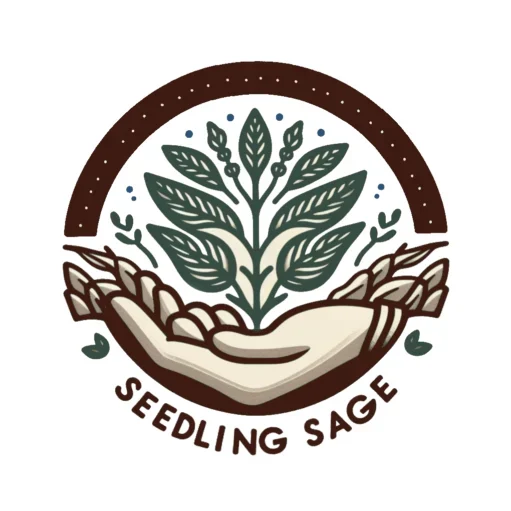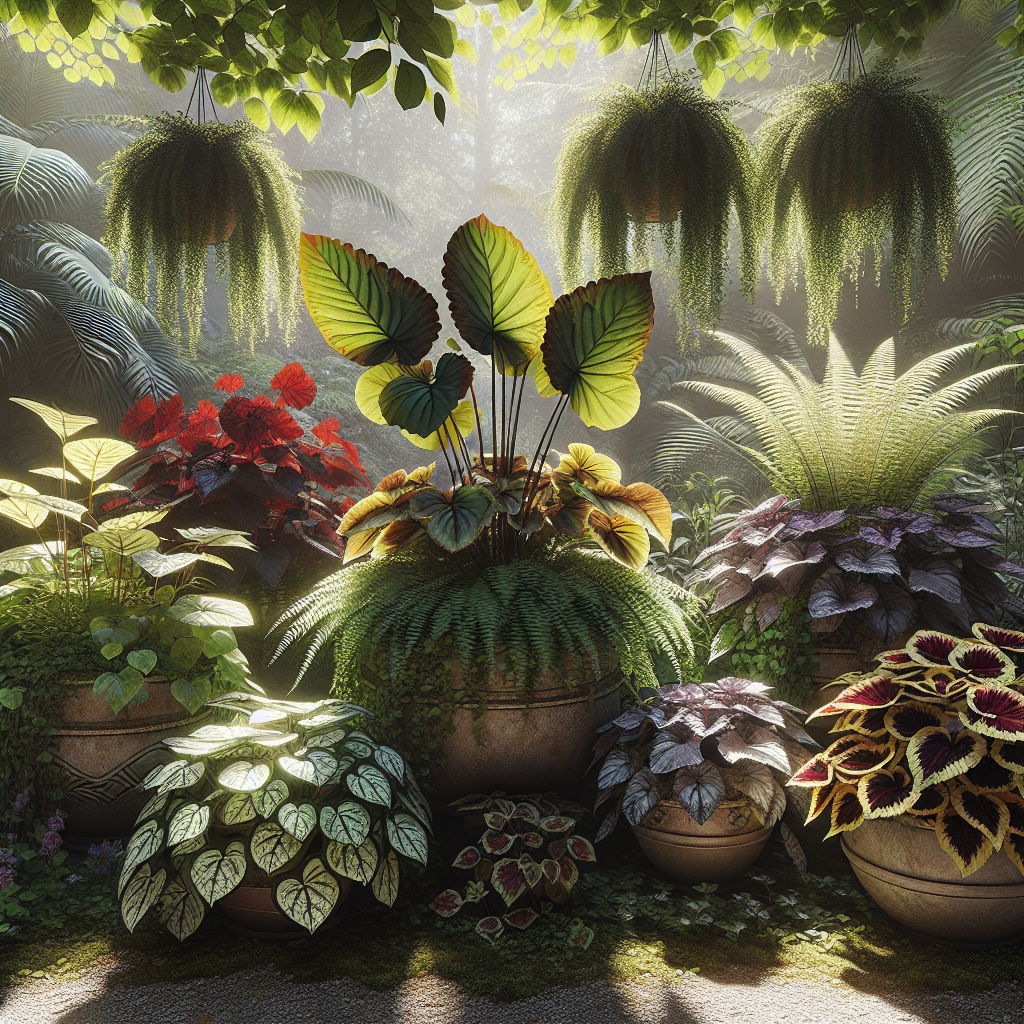Unlock Your Green Thumb: Picking the Perfect Seeds for Your Container Garden
August 25, 2025 | by Emma Sage
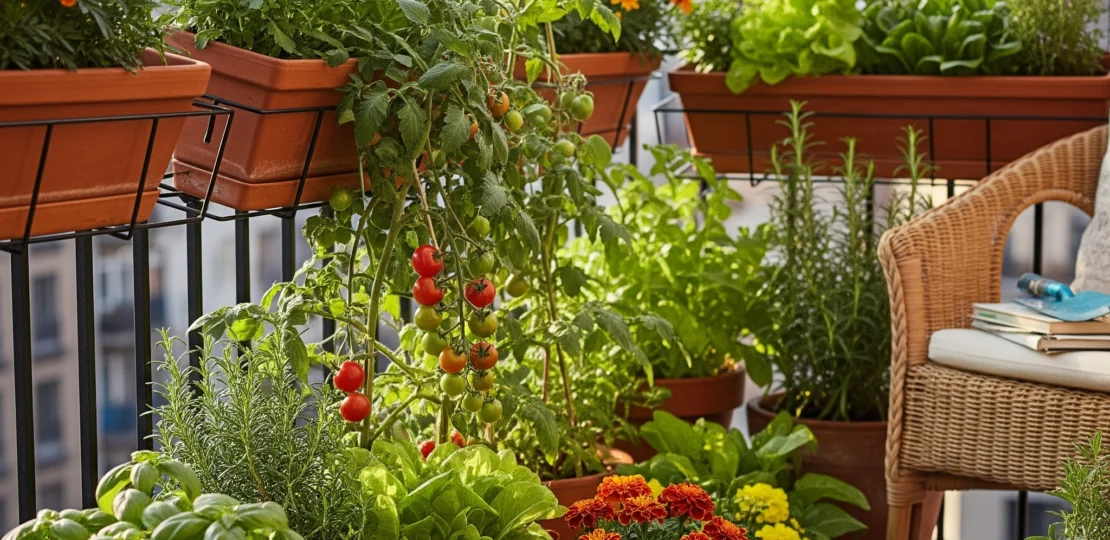
Hey there, fellow garden lovers! Emma Sage here, and I’m so thrilled you’re joining me on this green adventure. There’s something truly magical about bringing nature closer, especially when you might not have a big backyard. Container gardening has stolen my heart, allowing me to create a little green paradise right on my balcony, windowsill, or patio. It’s an incredible way to grow your own food, nurture beautiful flowers, and connect with the earth, no matter how much space you have.
I remember my very first container garden – a tiny terracotta pot with a hopeful basil seed. The excitement of seeing that first sprout push through the soil was truly unforgettable! It sparked a passion that has only grown since. But here’s a little secret: the journey to a thriving container garden starts way before you even get your hands dirty. It begins with choosing the right seeds.
It might seem like a small detail, but picking the perfect seeds for your pots and planters can make all the difference between a struggling plant and a flourishing one. Don’t worry, though! I’m here to share all my wisdom and help you make choices that will lead to a bountiful, beautiful container garden. Let’s dig in and discover how to set ourselves up for success from the very start!
Key Takeaways
- Choose “Compact” or “Dwarf” Varieties: These plants are specifically bred to stay small and fit perfectly in pots, making the most of your limited space.
- Match Seeds to Your Space & Sunlight: Understand how much sun your chosen spot gets and pick seeds that love those conditions to ensure happy, healthy plants.
- Prioritize Organic & Open-Pollinated Seeds: Support sustainable living and enjoy plants that are often more resilient and allow you to save seeds for future seasons.
- Read Seed Packets Carefully: Look for key information like “days to maturity,” “bush” vs. “vining,” and specific container-friendly notes before you buy.
- Start with Easy-to-Grow Favorites: Beginners can find great success with herbs, leafy greens, radishes, and dwarf tomatoes, building confidence for more adventures!
Why Container Gardening is So Awesome (and Why Seeds Matter!)
For so many of us, the idea of growing our own food or surrounding ourselves with vibrant flowers brings immense joy. But then we look around and think, “Where on earth will I put it all?” That’s where container gardening shines like a beacon of hope! ✨
It’s such a flexible and rewarding way to garden. You can move your plants to catch the best sun, protect them from bad weather, or simply rearrange them for a fresh look. It’s perfect for city dwellers, apartment living, or anyone who just wants to add a touch of green to their outdoor or indoor spaces.
“Container gardening lets you bring the magic of nature right to your doorstep, no matter your space!”
And why start with seeds, you ask? Oh, there are so many reasons!
- Variety Galore: When you buy starter plants, you’re limited to what the nursery has. Seeds? The options are endless! You can find unique varieties of tomatoes, rare herbs, or heirloom flowers that you might never see otherwise.
- Cost-Effective: A packet of seeds often costs less than a single starter plant, and it can give you dozens of plants! It’s a budget-friendly way to grow a lot.
- The Joy of Nurturing: There’s a special kind of pride that comes from watching a tiny seed sprout and grow into a thriving plant, all thanks to your care. It deepens your connection to nature.
- Sustainable Living: Starting from seed often means you’re more aware of where your plants come from, especially if you choose organic seeds. It aligns beautifully with our love for sustainable practices.
My own journey with seeds began with a desire to grow unique herbs that I couldn’t find at my local grocery store. I wanted specific types of basil and an array of mints! It was a small step, but it opened up a whole new world of gardening possibilities for me. It really showed me the power of starting small and nurturing something from the very beginning.
Understanding Your Container Garden’s “Home” (Space & Environment)
Before you even glance at a seed packet, take a good look at your growing area. This is the first, most important step in choosing the right seeds. Think of it like preparing a cozy home for your future plant babies!
Sunlight: Your Plants’ Favorite Meal ☀️
Sunlight is absolutely crucial for plants. Most vegetables and flowering plants need a lot of it!
- Full Sun (6+ hours of direct sun per day): This is ideal for most fruiting vegetables like tomatoes, peppers, eggplants, and many flowering plants. If you have a south-facing balcony or a sunny patio, you’re in luck!
- Partial Sun/Partial Shade (3-6 hours of direct sun, often in the morning): Many herbs, leafy greens (like lettuce and spinach), and some root vegetables can do well here.
- Shade (less than 3 hours of direct sun, or dappled light): Don’t despair if your spot is shady! There are still wonderful options. Think about plants like hostas, impatiens, and some ferns. For more ideas, you can explore shade-loving plants for containers.
Spend a day observing your space. Where does the sun hit? For how long? This simple observation will guide so many of your seed choices.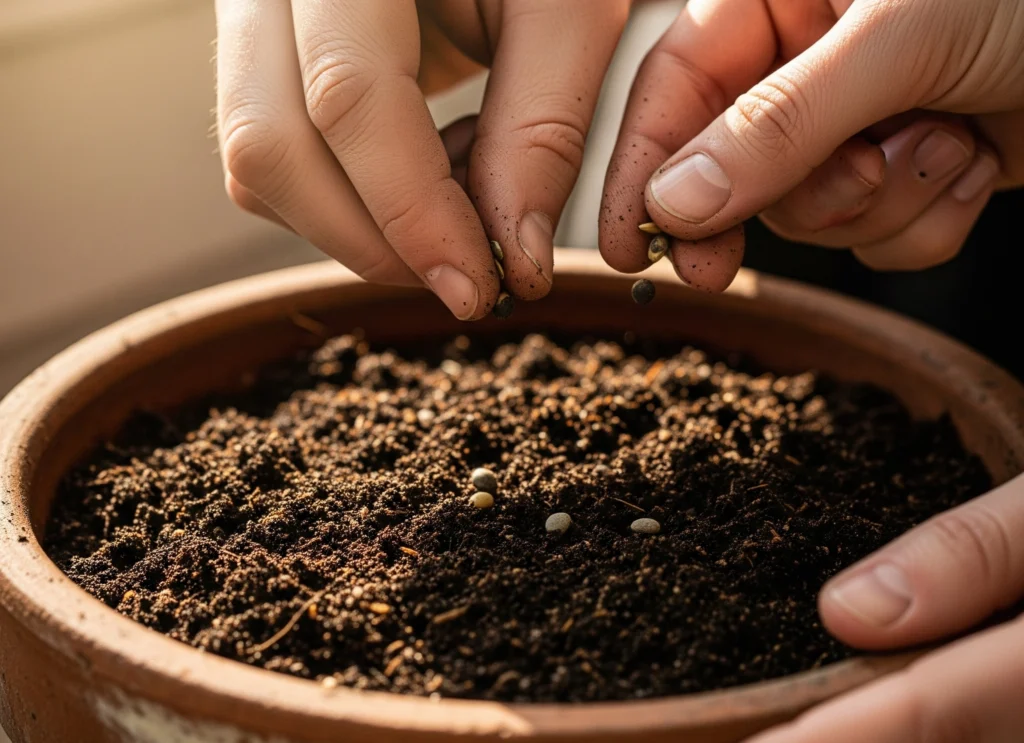
Climate: Knowing Your Local Weather 🌡️
Your local climate and growing zone play a big role too. Seeds have specific temperature needs for germination and growth.
- Frost Dates: Know your average last spring frost date and first fall frost date. You can find this information for your specific area by using a frost date calculator, which helps you figure out when it’s safe to plant outside.
- Summer Heat: Some plants bolt (go to seed) quickly in intense summer heat (like lettuce), while others thrive (like peppers).
- Humidity: Consider if your area is humid or dry, as this can affect watering needs and disease susceptibility.
I remember once being so excited to plant some cool-weather greens, only to have a surprise heatwave bolt them all before I could even harvest. Live and learn, right? Knowing your climate helps you pick seeds that will genuinely flourish.
Space: How Much Room Do You Really Have? 🪴
This might seem obvious, but it’s easy to get carried away!
- Container Size: Different plants need different sized pots. A tiny herb might be happy in a 6-inch pot, but a dwarf tomato needs at least a 5-gallon container.
- Vertical Space: Can you use trellises? Hanging baskets? This can expand your growing area significantly.
- Arrangement: How will your containers fit together? Do you need plants that stay compact or can you let some spill over?
Think about both the root space your plants will need and the space the mature plant will take up above ground.
The Secret Sauce: What to Look for in Seeds for Containers
Once you understand your growing environment, it’s time for the fun part: picking seeds! But not just any seeds. We’re looking for specific qualities that make them perfect for life in a pot.
“Dwarf” or “Compact” Varieties: Your Container’s Best Friend 🤏
This is probably the most important thing to look for. Many popular vegetables and flowers have been bred into smaller, “dwarf,” “patio,” or “compact” versions.
- Why they’re great: They stay smaller, meaning their roots won’t outgrow their container as quickly, and they won’t overwhelm your limited space. They also often produce fruit or flowers earlier.
- Examples: Look for “patio tomatoes,” “bush cucumbers,” “dwarf sunflowers,” or “compact basil.”
Bush vs. Vining: Knowing Their Growth Habit 🌿
This is especially critical for plants like cucumbers, squash, and some beans.
- Bush Varieties: These grow in a more contained, bushy shape. They are ideal for containers because they don’t spread out or climb extensively.
- Vining Varieties: These love to spread and climb, often needing a trellis or a lot of ground space. While some vining plants can be trained in large containers with support, bush varieties are generally much easier for beginners and smaller spaces.
Always check the seed packet to see if it says “bush” or “vining.” Trust me, you don’t want a massive vining cucumber plant trying to take over your small balcony!
Days to Maturity: Patience is a Virtue, But Planning is Key! 🗓️
This number tells you how long it will take from the time you plant your seed (or transplant a seedling) until you can harvest your first crop.
- Why it matters: In containers, we often want quicker turnaround. Plus, it helps you plan successive plantings throughout your growing season.
- Consider: If you have a short growing season, pick varieties with shorter “days to maturity.”
Disease Resistance: A Little Extra Protection 💪
Some seed varieties are bred to be resistant to common plant diseases. This can be a huge help, especially if you’ve struggled with particular issues in the past or want to minimize your gardening worries. Look for codes like “VFN” (Verticillium, Fusarium, Nematodes) on tomato packets.
Open-Pollinated, Heirloom, or Hybrid: Understanding Your Seed’s Family Tree 🌳
This is where our sustainable living values really come into play!
- Open-Pollinated (OP): These seeds, when pollinated by wind, insects, or other natural means, will produce plants that are true to type. This means if you save seeds from an open-pollinated plant, the next generation will look and taste like the parent. This is amazing for seed saving!
- Heirloom: A type of open-pollinated seed that has been passed down through generations, often for 50 years or more. They are celebrated for their unique flavors, colors, and stories.
- Hybrid (F1): These seeds are created by cross-pollinating two different parent plants to get specific desirable traits (like disease resistance or higher yield). The catch? If you save seeds from a hybrid plant, the offspring won’t be true to type; they might revert to one of the parent plants or be sterile.
For Seedling Sage, we lean towards open-pollinated and heirloom seeds because they truly embody the spirit of sustainability, community, and the joy of nurturing nature for generations to come. It’s a wonderful feeling to know you can save your own seeds and share them with friends!
Organic Seeds: Nurturing the Earth from the Start 🌍
Choosing organic seeds means they were grown without synthetic pesticides or fertilizers, aligning perfectly with our mission for sustainable living. It’s a small but significant step towards a healthier garden and a healthier planet. When you choose organic, you’re supporting practices that are kind to the earth. You can learn more about finding great supplies for your eco-friendly garden by checking out our guide on organic container gardening supplies or even dive deeper into organic vegetable container gardening.
Top Picks: My Favorite Seeds for Container Success!
Okay, let’s get to some actionable insights! Based on my own experiences and what I’ve seen flourish in pots, here are some fantastic seed choices for your container garden.
Veggies That Love Containers 🥕🍅🌶️
These are truly some of the best plants to grow from seed in pots, offering delicious harvests without taking over your space. You can find even more ideas in our article on vegetables that grow well in containers.
- Lettuce & Leafy Greens (Loose-leaf varieties): 🥬
- Why they’re great: Quick to grow, tolerant of partial shade, and you can harvest outer leaves for a continuous supply. Look for “cut-and-come-again” varieties.
- My pick: ‘Black Seeded Simpson’ or ‘Buttercrunch’ lettuce.
- Radishes: 💖
- Why they’re great: Super fast! You can go from seed to harvest in as little as 3-4 weeks. They don’t need deep soil.
- My pick: ‘Cherry Belle’ or ‘French Breakfast’.
- Bush Beans: 🌱
- Why they’re great: Unlike pole beans, bush beans stay compact and don’t need trellises. They produce a good harvest in a small footprint.
- My pick: ‘Provider’ or ‘Contender’.
- Compact Tomatoes: 🍅
- Why they’re great: Bred specifically for pots, these stay small but still give you tasty fruit. Look for “patio,” “dwarf,” or “bush” varieties. Cherry tomatoes are often a good bet.
- My pick: ‘Tiny Tim’ or ‘Patio Princess’.
- Small Peppers: 🌶️
- Why they’re great: Many pepper varieties naturally stay quite compact, especially smaller bell peppers or hot peppers.
- My pick: ‘Lunchbox’ peppers (sweet) or ‘Jalapeño M’ (hot).
- Carrots (Short Varieties): 🥕
- Why they’re great: Choose varieties that are bred for shorter roots to avoid needing super deep pots.
- My pick: ‘Danvers 126’ or ‘Paris Market’.
- Dwarf Eggplant: 🍆
- Why they’re great: Some varieties offer beautiful, smaller eggplants on a compact plant.
- My pick: ‘Fairy Tale’ or ‘Patio Baby’.
- Bush Zucchini/Squash: 🎃
- Why they’re great: Zucchini can be notorious for taking over, but bush varieties are a game-changer for containers.
- My pick: ‘Bush Baby’ zucchini or ‘Patio Star’ squash.
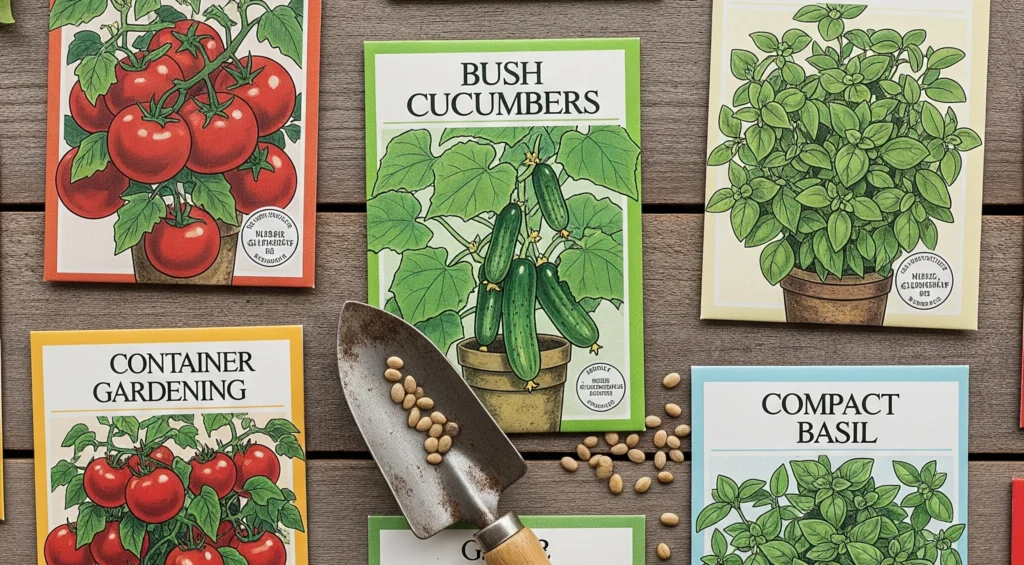
Herbs for Your Potted Pantry 🌿✨
Herbs are absolute stars in container gardens. They’re often naturally compact, incredibly fragrant, and so rewarding to have fresh at your fingertips. For more inspiration, check out our guide to herbs for container gardening.
- Basil: 💚
- Why it’s great: Easy to grow, loves sun, and perfect for Italian cooking. Pinch back regularly for bushier growth.
- My pick: ‘Genovese’ or ‘Dwarf Greek’.
- Mint: 🌱
- Why it’s great: Mint is a notorious spreader in the ground, making it perfect for containers where its roots are contained!
- My pick: ‘Mojito Mint’ or ‘Peppermint’.
- Chives: 🧅
- Why they’re great: Grow in neat clumps, easy to harvest, and come back year after year.
- My pick: Common chives.
- Parsley: 🌿
- Why it’s great: A kitchen staple, can tolerate some partial shade, and adds freshness to so many dishes.
- My pick: ‘Italian Flat Leaf’ or ‘Moss Curled’.
Flowers for Beauty and Pollinators 🌼🐝
Don’t forget the flowers! They add beauty, attract beneficial pollinators, and can even help deter pests.
- Marigolds: 🧡
- Why they’re great: Cheerful, easy to grow, and often said to deter nematodes and other pests (a great companion plant!).
- My pick: ‘French Marigold’ varieties like ‘Disco Mix’.
- Nasturtiums: 🌸
- Why they’re great: Both beautiful and edible! The leaves and flowers have a peppery taste. Look for bush varieties.
- My pick: ‘Alaska’ or ‘Jewel Mix’.
- Dwarf Sunflowers: 🌻
- Why they’re great: Get that iconic sunflower charm without the towering height. Perfect for a sunny corner.
- My pick: ‘Teddy Bear’ or ‘Pacino Gold’.
Where to Find Your Perfect Seeds (and What to Ask!)
Finding seeds is part of the fun! You have several great options, and each has its own charm.
Local Nurseries & Garden Centers 🏡
- Pros: You can see the packets in person, ask staff for local advice, and sometimes find local or regional varieties. It’s a wonderful way to support local businesses.
- Cons: Selection might be smaller than online, especially for very specific dwarf or heirloom varieties.
Online Seed Retailers 💻
- Pros: Enormous selection! You can find almost any variety you can dream of, including many organic, heirloom, and dwarf options. Many specialize in sustainable practices.
- Cons: You can’t physically examine the packet, and shipping costs can add up. Order from reputable companies with good reviews.
Seed Swaps & Community Gardens 🤝
- Pros: A fantastic way to connect with other gardeners, share unique varieties, and save money. It fosters community and sustainable practices.
- Cons: Selection is hit-or-miss, and you might not always get detailed growing information.
What to Look for on the Seed Packet:
No matter where you buy your seeds, always, always read the packet! It’s packed with crucial information:
- Plant Name: Common and botanical names.
- Variety Name: This is where you’ll see “Dwarf,” “Patio,” “Bush,” etc.
- Days to Maturity: How long until harvest.
- Sunlight Needs: Full sun, partial sun, etc.
- Planting Depth & Spacing: How deep to plant seeds and how far apart.
- Container Size Suggestion: Some packets even tell you the ideal pot size!
- Organic/Heirloom/Hybrid: Often clearly labeled.
- Germination Rate/Date: Sometimes included, indicating how likely the seeds are to sprout.
“A little time spent reading the seed packet can save you a lot of heartache later!”
I’ve learned this the hard way more than once! One year, I planted a regular zucchini in a container, thinking it would be fine. It quickly became a monster, sending vines everywhere and trying to escape the pot! If I’d just read the packet, I would have seen “vining” and known to pick a “bush” variety instead. Lesson learned!
Beyond the Seed: Setting Your Container Garden Up for Success
Choosing the right seeds is a huge first step, but it’s just the beginning of your nurturing journey. To truly cultivate growth and harvest wisdom, you need to give those seeds the best possible start.
Soil: The Foundation of Life 🪨
The right soil is non-negotiable for container plants. They can’t send roots out to find nutrients like in-ground plants.
- Use a high-quality potting mix: This is different from garden soil. Potting mix is lighter, drains well, and provides the aeration roots need in a confined space.
- Look for organic options: This aligns with our sustainable values and provides a healthy, chemical-free start for your plants. For my go-to recommendations, check out my guide on the best organic soil for container gardening.
Containers: Size and Drainage Matter! 💧
- Size: As mentioned, match the pot size to the mature plant’s needs. Too small, and your plant will be stunted and dry out quickly.
- Drainage: Absolutely essential! Make sure every pot has drainage holes at the bottom. Without them, roots will sit in soggy soil and rot.
Watering & Feeding: Consistent Care 🌧️🍽️
Container plants dry out faster than in-ground plants, so consistent watering is key.
- Check daily: Stick your finger into the soil. If it feels dry an inch or two down, it’s time to water.
- Feed regularly: Since nutrients leach out of pots with watering, your plants will need a boost. Use an organic fertilizer to keep them happy and healthy. Discover my favorite tips and products in our article about organic fertilizer for container plants.
Light: Revisit Your Sunlight Observations ☀️
Remember how we talked about observing your sunlight? Keep that in mind as your plants grow. If a plant isn’t thriving, consider if it’s getting enough (or too much) sun. The beauty of containers is you can usually move them!
For those just starting out, or looking for a refresher on the basics, I highly recommend our complete guide to organic container gardening for beginners. It covers everything you need to know to get started with confidence.
My Story: A Little Seed of Wisdom
I remember one spring, I was so excited to grow carrots in a container. I diligently chose a “short and stout” variety, found a deep enough pot, and planted my tiny seeds. Weeks went by, and while the feathery green tops looked lovely, every time I peeked, the carrots themselves seemed tiny. I was getting discouraged, thinking I’d done something wrong.
Then, a friend, a seasoned gardener with hands stained from years of working the earth, reminded me, “Emma, patience is a gardener’s best tool. Sometimes, you just have to trust the process.” She also gave me a knowing look and said, “And make sure you’re not overwatering. Carrots like consistent moisture, but not soggy feet!”
I realized I’d been too eager, overchecking and probably overwatering a bit. I stepped back, let the soil dry out a little between waterings, and simply trusted. A few weeks later, when I finally harvested, I pulled out the most beautiful, sweet, stubby carrots! They weren’t huge, but they were perfectly formed and absolutely delicious.
That experience taught me that choosing the right seed is essential, but so is the quiet act of nurturing, observing, and sometimes, simply letting nature do its thing. It’s about patience, learning, and finding joy in every stage of growth.
Nurturing Your Green Paradise: A Final Word
Choosing the right seeds for your container garden is more than just a practical step; it’s an act of intention. It’s about setting yourself up for success, embracing sustainable living, and making thoughtful choices that will bring you closer to nature.
Whether you’re growing a tiny basil plant on your windowsill or a vibrant collection of dwarf vegetables on your patio, remember that every seed holds the promise of life, growth, and delicious harvests. By picking varieties suited for containers, understanding your space, and nurturing your plants with love and care, you’re not just growing food or flowers – you’re cultivating a deeper connection to the earth and fostering a green paradise of your very own.
So, go ahead, explore those seed catalogs, visit your local garden center, and pick out those perfect little packages of potential. I can’t wait to hear about your container gardening adventures and see what amazing things you grow! Keep growing, keep learning, and keep flourishing! Happy gardening!
RELATED POSTS
View all
